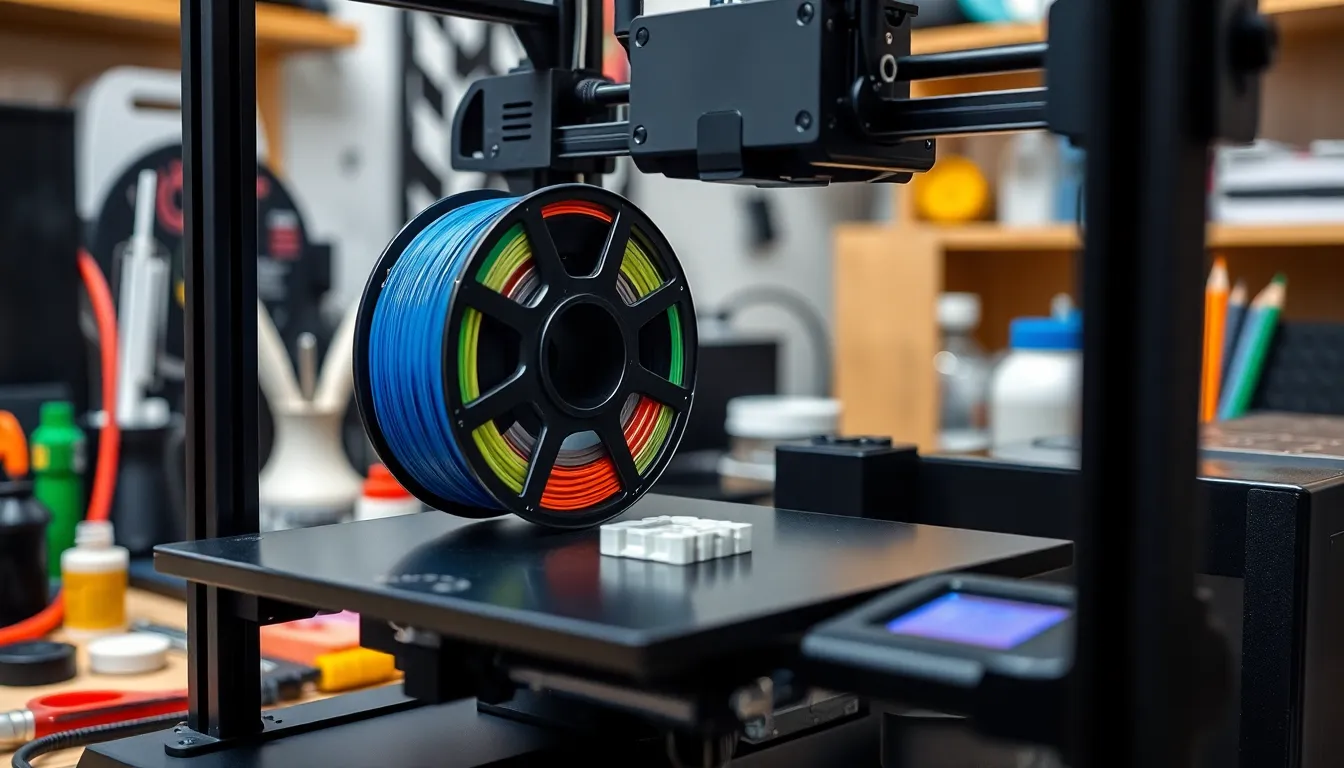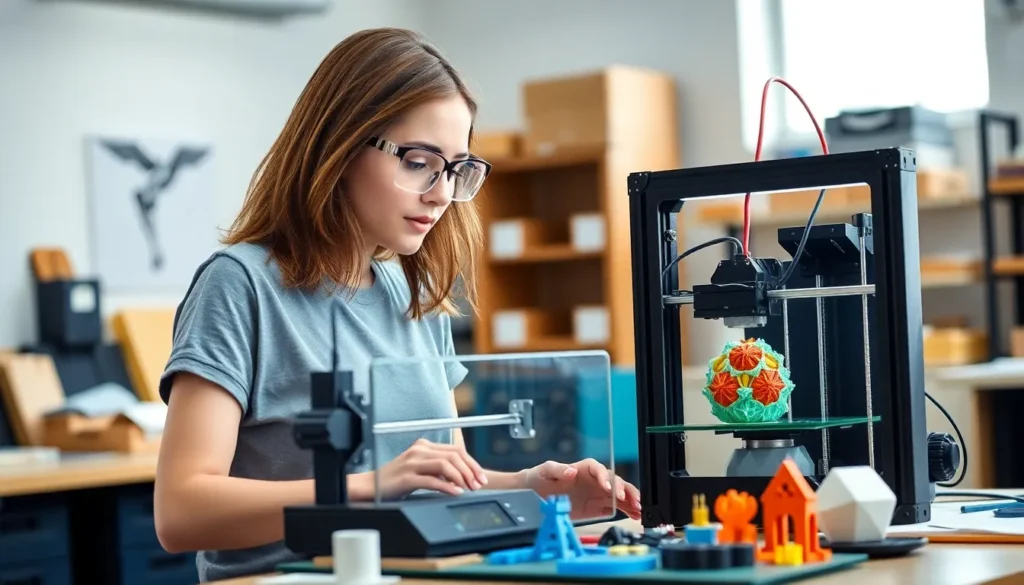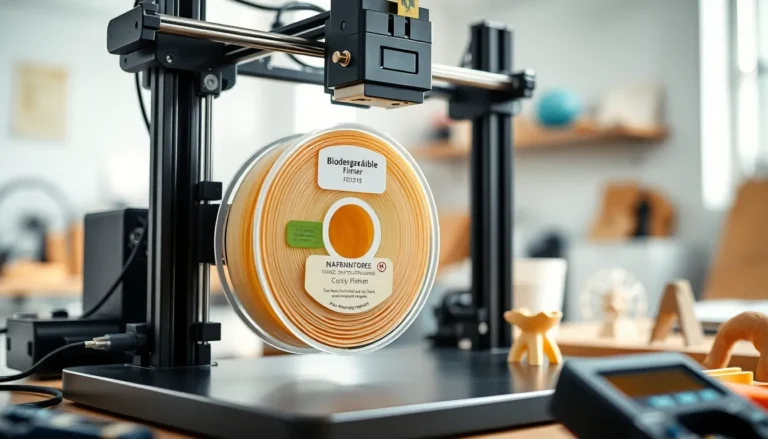In recent years, personal 3D printers have transformed from niche gadgets into essential tools for hobbyists and professionals alike. With the ability to turn digital designs into tangible objects, these printers have opened up a world of creativity and innovation. Whether it’s crafting custom prototypes, unique home decor, or even functional tools, the possibilities are endless.
As technology advances and prices become more accessible, more people are discovering the benefits of owning a personal 3D printer. From educators enhancing classroom experiences to entrepreneurs prototyping their next big idea, the impact of this technology is profound. Understanding the features and capabilities of these printers can help users make informed decisions and maximize their creative potential.
Table of Contents
ToggleOverview of Personal 3D Printers
Personal 3D printers have emerged as versatile devices that empower users to create custom objects from digital files. These printers operate on various technologies, including Fused Deposition Modeling (FDM), Stereolithography (SLA), and Selective Laser Sintering (SLS). Each technology offers distinct advantages, catering to different needs.
Key Features
- Build Volume: The physical space where prints occur varies by model. Larger build volumes accommodate more extensive projects or multiple smaller designs.
- Layer Resolution: Measured in microns, resolution determines the detail in each print. Higher resolutions yield finer details, crucial for intricate designs.
- Material Compatibility: Personal 3D printers support various materials, such as PLA, ABS, and specialized filaments. Each material affects durability, flexibility, and finish quality.
- Print Speed: Speed influences project timelines. Faster printers complete designs quickly, useful for urgent tasks.
- User Interface: Intuitive interfaces simplify the printing process, making it accessible for beginners. Touchscreens, Wi-Fi connectivity, and mobile app control enhance the user experience.
Applications
Personal 3D printers serve multiple applications. Hobbyists utilize them for designing custom toys and art pieces. Professionals create prototypes and parts for industries like engineering and healthcare. Educators integrate 3D printers into classrooms, fostering creativity and hands-on learning.
Market Trends
The market for personal 3D printers is growing rapidly. Prices have decreased, making these devices more accessible. Technological advancements enhance functionality and user-friendliness. As a result, more users recognize their potential in fostering innovation and customization.
Conclusion
Understanding the features and advancements in personal 3D printers facilitates informed decisions. As the technology evolves, users can unlock new creative opportunities, leading to improved designs and products tailored to specific needs.
Types of Personal 3D Printers

Personal 3D printers fall into several categories, each utilizing distinct technologies to cater to various needs and preferences. Understanding these types aids in selecting the right printer for specific applications.
FDM Printers
Fused Deposition Modeling (FDM) printers are among the most popular personal 3D printers. They work by melting plastic filament and extruding it layer by layer to create objects.
- Material Variety: FDM printers support a range of thermoplastics, including PLA, ABS, and PETG.
- Build Volume: Many FDM models offer varying build volumes, accommodating small to medium-sized objects.
- Ease of Use: They typically feature user-friendly interfaces, making them accessible for beginners.
- Cost-Effectiveness: FDM printers are generally more affordable than other types, appealing to hobbyists and educators.
SLA Printers
Stereolithography (SLA) printers utilize a different methodology, using a laser to cure liquid resin into solid layers.
- High Resolution: SLA printers achieve finer details and smoother finishes compared to FDM printers.
- Material Selection: They employ various types of resin, offering unique properties like flexibility or high detail.
- Print Speed: SLA technology can produce complex models quickly, especially for detailed prototypes.
- Post-Processing Requirements: Finished prints often require additional cleaning and curing, increasing overall production time.
Understanding these printer types and their characteristics enables users to make informed decisions based on their specific needs and goals in 3D printing.
Key Features to Consider
Understanding key features significantly impacts the user experience with personal 3D printers. Each feature plays a crucial role in determining what printer best meets user needs.
Build Volume
Build volume refers to the maximum size of objects that a printer can create. It’s measured as width, depth, and height in millimeters. A larger build volume accommodates bigger projects, beneficial for creating prototypes or functional parts. For example, printers with a build volume of 300 x 300 x 400 mm allow users to realize more extensive designs without needing to assemble multiple smaller printed pieces. Users often prioritize build volume based on their specific project requirements.
Print Quality
Print quality encompasses factors like layer resolution and surface finish. Layer resolution, measured in microns, indicates how thin each layer can be; lower microns yield finer details and smoother surfaces. For instance, a printer with a resolution of 50 microns is ideal for intricate models, whereas 200 microns may suffice for less detailed objects. Users should evaluate their quality requirements in relation to their intended applications, ensuring the printer meets their expectations for detail and finishing.
Material Compatibility
Material compatibility affects the versatility and range of projects a printer can handle. Common materials include PLA, ABS, PETG, and resin, each serving different purposes and preferences. For example, PLA is user-friendly and ideal for beginners, while ABS offers higher durability for functional parts. Some printers support multiple filaments, enabling users to experiment with various materials and finishes. Checking compatibility with preferred materials ensures the printer aligns with specific project needs.
Applications of Personal 3D Printers
Personal 3D printers serve diverse applications, enhancing creativity and practicality for various users. They facilitate projects ranging from hobbyist creations to professional design prototypes.
Hobbyist Creations
Personal 3D printers empower hobbyists to design and produce unique items tailored to their interests. Users create custom toys, intricate figurines, decorative art pieces, and functional gadgets at home. They utilize various materials, including plastic filaments like PLA and ABS, to achieve different finishes and features. Enthusiasts can experiment with designs using CAD software, bringing imaginative concepts to reality. Examples include personalized phone cases, DIY home decor, and customized board game pieces.
Prototyping and Design
Personal 3D printers play a crucial role in prototyping and design across multiple industries. Designers and engineers leverage these tools to create accurate, tangible representations of products, streamlining the development process. They iterate designs quickly, making adjustments based on testing and feedback. Common applications include prototypes for consumer electronics, automotive components, and medical devices. This rapid prototyping enhances collaboration between teams, reduces time-to-market for new products, and lowers production costs by minimizing material waste. High-resolution SLA printers often excel in producing detailed prototypes, capturing intricate designs that meet professional standards.
Choosing the Right Personal 3D Printer
Selecting the right personal 3D printer involves evaluating several essential features. Understanding these features helps users enhance their creative process and achieve desired results.
- Build Volume: Build volume represents the maximum dimensions of objects a printer can create. Larger volumes accommodate bigger projects, while smaller volumes suit compact designs. Users should assess their typical project sizes before choosing a printer.
- Layer Resolution: Layer resolution determines the detail level in printed objects. A higher resolution results in finer details, which is crucial for intricate designs and functional prototypes. Users should align their resolution needs with their intended applications.
- Material Compatibility: Material compatibility affects the range of projects a printer can handle. Common materials include PLA, ABS, and PETG. Users should consider the materials they wish to work with and select a printer that supports those options.
- Print Speed: Print speed indicates how quickly a printer can produce objects. Faster print speeds enhance productivity, particularly for larger projects. Users should balance speed with quality, as higher speeds may compromise detail.
- User Interface: An intuitive user interface simplifies the printing process. Touchscreens, Wi-Fi connectivity, and user-friendly software contribute to a smoother experience. Users should prioritize printers that offer easy setup and operation.
- Support and Community: A strong support network, including manufacturers’ resources and online communities, provides users with solutions to potential issues. Checking for available customer support and active user forums can aid users in their 3D printing journey.
- Price: Price varies significantly across personal 3D printers. Consideration of budget constraints ensures users select a printer that meets their financial needs without sacrificing essential features. Researching options within a specified budget can reveal suitable choices.
By thoroughly evaluating these factors, users can confidently choose a personal 3D printer that aligns with their specific needs and goals in 3D printing.
Personal 3D printers have revolutionized the way individuals approach creativity and design. As technology continues to advance and prices drop, these printers are becoming accessible to a wider audience. Users can now explore endless possibilities in custom creations and professional prototyping.
By understanding the various types of printers and their features, users can make informed decisions that cater to their specific needs. Whether for hobbyists or professionals, personal 3D printers are set to play a significant role in shaping the future of innovation and creativity. Embracing this technology opens the door to a world where imagination turns into reality.




